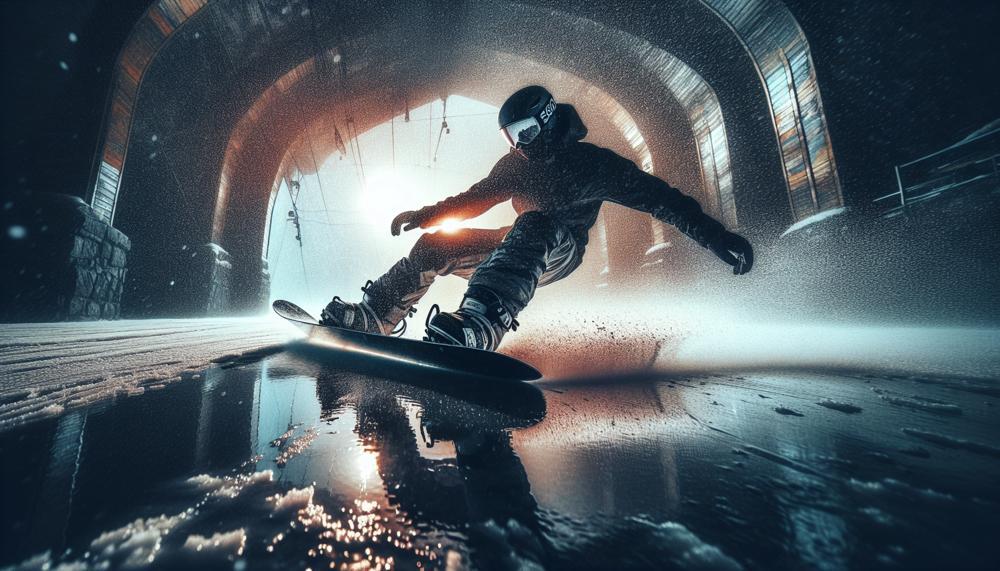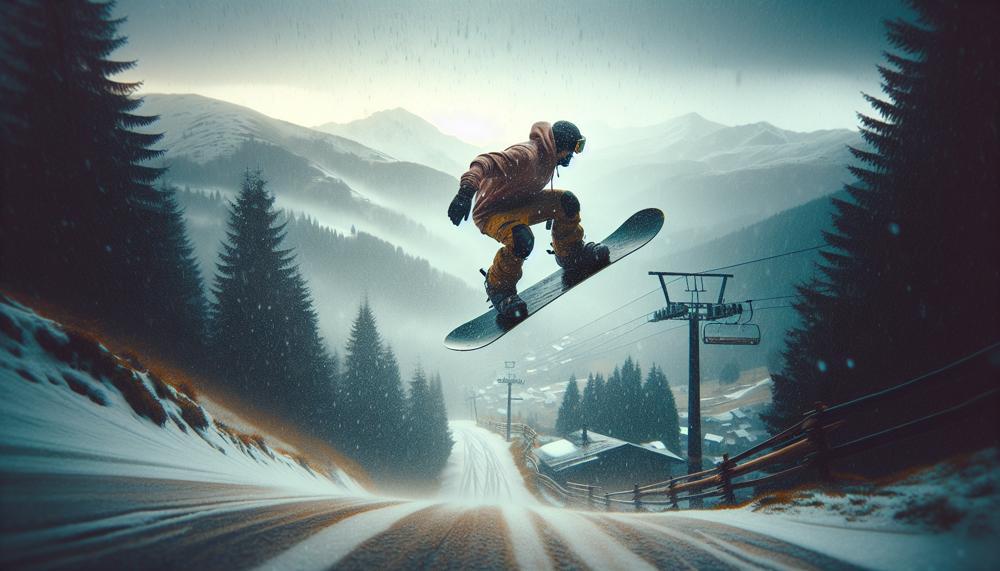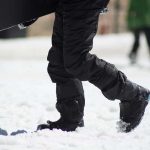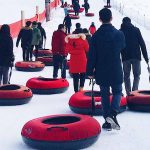Imagine standing atop a snow-capped mountain, adrenaline coursing through your veins as you prepare to conquer the slopes. But just as you’re about to take off, you feel a few raindrops on your face.
Your heart sinks and you think, “Well, there goes my day of snowboarding.” But don’t let those pesky raindrops ruin your plans just yet. In fact, snowboarding in the rain can be an exhilarating experience that seasoned riders swear by.
So, how do you snowboard in the rain?
Here are some tips for snowboarding in wet snow:
- Avoid catching an edge: Keep your weight centered over your board and slide through turns instead of carving on your edges.
- Use a lighter touch: In rain, the snow will be fine, usually a bit heavy, soft and slow. Be careful of really saturated areas as they can be grabby.
- Bring an extra change: All your clothes that you thought where waterproof, turn out not to be waterproof.
So, instead of packing up and heading back to the lodge at the first sign of rain, grab your rain jacket and join us as we dive into everything you need to know about shredding on a rainy day.
Understanding the Risks of Snowboarding in the Rain
Contents
Snowboarding in the rain can be an exhilarating adventure, but it also presents its own set of hazards and risks. These dangers include reduced visibility, slippery surfaces, hypothermia, and an increased likelihood of accidents.
To ensure a safe and enjoyable experience while snowboarding in the rain, it is crucial to take certain precautions and adequately prepare for wet conditions.
One of the major hazards when hitting the slopes in the rain is reduced visibility. This can make it difficult to see obstacles and changes in terrain, significantly increasing the risk of accidents. To mitigate this danger, make sure to equip yourself with proper gear such as goggles with low-light lenses and avoid riding in areas with flat light.
Another danger to watch out for when snowboarding in the rain is slippery surfaces. The rain can wash away snow, creating icy patches and rough surfaces that can lead to falls and injuries. To minimize this risk, ensure that your gear is waterproof and that your bindings are properly adjusted and securely fastened.
Additionally, hypothermia is a real concern when engaging in snowboarding activities in the rain. Wet clothing can cause the body to lose heat quickly, resulting in dangerous drops in body temperature. To prevent this, it is essential to wear warm layers underneath your waterproof gear and take regular breaks to warm up and dry off.
In general, poor weather conditions can significantly increase the chances of accidents while snowboarding. Therefore, it is crucial to exercise extra caution and avoid taking unnecessary risks in wet conditions.
This includes regularly checking weather forecasts and accurately interpreting them, as well as considering alternative activities if the rain becomes too heavy or dangerous conditions arise.
Tips for Snowboarding in the Rain Safely
Snowboarding in the rain can be an exhilarating experience, but it also comes with its fair share of risks. Slippery slopes and reduced visibility can increase the chances of accidents and injuries.
However, with proper precautions and gear, you can safely enjoy this unique activity. Here are some tips to keep in mind when snowboarding in the rain:
Understand the Risks
- Be aware of the potential dangers associated with snowboarding in the rain, such as slippery slopes and reduced visibility.
- Take extra caution and ride at a slower pace to minimize risks.
Invest in Proper Gear
- Waterproof clothing, goggles with anti-fog coating, and a helmet are essential to stay dry and comfortable while snowboarding in the rain.
- Layer up with warm and moisture-wicking clothing underneath for added protection.
Adjust Your Riding Technique
- Keep your weight centered and use shorter turns to maintain control and minimize risks while snowboarding in the rain.
- Stay aware of your surroundings and be prepared to adjust your technique to changing weather conditions.
Prepare for the Elements
- Check weather forecasts before heading out and interpret them correctly to plan accordingly.
- Bring extra layers, such as a waterproof jacket and pants, to stay warm and dry.
- Stay hydrated throughout your ride to combat the effects of rain on your body.
Know When to Call it Quits
- Recognize signs of fatigue, decreased visibility, or worsening weather conditions, and know when it’s time to stop snowboarding in the rain.
- Don’t push yourself beyond your limits and prioritize your safety at all times.
Additional Tips for Snowboarding in the Rain:
- Clean and dry your snowboard before and after riding to prevent damage from moisture.
- Apply wax to protect the board from rain and create smoother slides.
- Ensure that your bindings are properly adjusted and securely fastened.
- Consider alternative activities like indoor snowboarding facilities or outdoor activities such as hiking, fishing, camping, kayaking, or mountain biking if the rain becomes too heavy or dangerous conditions arise.
By following these safety precautions and tips, you can enjoy snowboarding in the rain while minimizing risks and staying safe. Remember to always prioritize your safety and be prepared for any changes in weather conditions.
Essential Gear for Snowboarding in the Rain
When venturing out for a rainy day snowboarding trip, there are several gear items that every savvy snowboarder should have in their arsenal. These items not only enhance performance and comfort, but also ensure safety and protection against the elements.
| Protective Gear | To keep yourself dry and shielded from the rain, it’s essential to have a waterproof jacket and pants. Look for materials such as Gore-Tex, which provide both waterproofing and breathability. Additionally, gloves and a hat can keep your hands and head warm and dry. |
| Snowboarding Boots | Investing in insulated snowboarding boots is crucial for warmth and comfort while riding in the rain. Opt for boots with a waterproof outer layer and good insulation to keep your feet dry and warm. |
| Sun Protection | Despite the rain, UV rays can still be strong on a cloudy day. Protect your eyes with sunglasses, your skin with sunscreen, and your lips with lip balm. |
| Snacks and Water | To ensure you stay hydrated and energized while snowboarding in any condition, pack high-energy snacks like granola bars or trail mix, and bring a water bottle to stay hydrated throughout the day. |
| Additional Items | While not necessarily essential, these items can elevate your experience on the slopes. A backpack is great for storing extra layers, snacks, and other necessary items. Wax can also improve performance on wet snow, while a stomp pad can provide better grip on your board. It’s also wise to bring a first aid kit in case of any accidents or injuries. |
By having these essential gear items, you can ensure a safe, comfortable, and enjoyable snowboarding experience even in the rain.
However, it’s crucial to always check the weather and conditions before heading out and to know when to stop if the conditions become too hazardous.
How to Prepare Your Snowboard for Riding in the Rain
To guarantee your snowboard is prepared for riding in the rain, follow these steps:
- Familiarize yourself with your snowboard’s unique features: Before getting your snowboard ready for rainy conditions, it’s crucial to understand its flexibility, camber shape, length, width, sidecut radius, and base material. This understanding can help you select the right board for your riding style and prepare it appropriately.
- Regularly maintain and clean your board: Consistent maintenance and cleaning can prevent damage and enhance performance. Before and after riding in the rain, ensure to clean and dry your board to avoid any harm from dirt and debris.
- Choose the perfect snowboard: Matching your riding style to your board is vital for optimum performance in any weather condition. Take into account factors like skill level, riding style, preferred terrain, body type, shape, flexibility, and camber shape when choosing a snowboard.
- Wax regularly: Applying wax can safeguard your board from rain and create smoother slides on the snow. Make sure to use suitable wax for rainy conditions to enhance performance.
- Adjust bindings accordingly: Properly adjusting bindings according to riding style, stance, and comfort level can ensure a secure fit that allows for optimal control on the slopes.
- Address issues immediately: While regular maintenance can prevent many problems with a snowboard, it’s essential to address any issues promptly to avoid further damage or injury while riding in rainy conditions.
- Consider alternative activities: If the rain becomes too intense or dangerous conditions arise, consider alternative activities like indoor snowboarding facilities or outdoor activities such as hiking, fishing, camping, kayaking, or mountain biking. These activities can still provide an enjoyable experience despite the rainy weather.
Alternatives to Snowboarding in the Rain
When the weather doesn’t cooperate for snowboarding, there are plenty of other exciting outdoor activities that can get your heart pumping and provide a similar adrenaline rush. Instead of hitting the slopes in the rain, you could try indoor snowboarding, mountain biking, white-water rafting, surfing, or zip lining. Each of these options offers its own unique thrills and challenges, making them fantastic alternatives to snowboarding in wet conditions.

One exhilarating alternative to snowboarding in the rain is indoor snowboarding. This activity allows you to experience the thrill of snowboarding while staying warm and dry indoors. With ever-advancing technology, indoor snowboarding facilities are becoming more popular and offer a realistic experience that will make you forget about the bad weather outside.
Mountain biking is another great option. It provides a similar feeling of speed and control as snowboarding, but on two wheels instead of one. Plus, you can still enjoy the beautiful scenery and fresh air while tackling challenging trails.
If you’re looking for a water-based adventure, white-water rafting is an excellent alternative to snowboarding in the rain. It will get your heart racing as you navigate through rapids and take on the power of the river. Plus, you’ll be surrounded by stunning natural landscapes that will take your breath away.
Surfing is a thrilling alternative to snowboarding in wet conditions. The feeling of catching a wave and riding it to shore is like no other, and it’s an ideal activity for those adventurous souls who don’t mind getting wet.
And for a truly unique experience, zip lining offers a different kind of thrill. Soar through the air at high speeds while taking in breathtaking views from above. It’s a great way to get your adrenaline fix while also enjoying some stunning scenery.
Also Read: How To Make A Boat That Floats And Holds Weight?
Conclusion
In conclusion, don’t let a little rain dampen your snowboarding plans.
While not the most popular option, shredding in the rain can be an exhilarating and unforgettable experience. From unexpected challenges to surprising benefits, there are numerous reasons to give it a try.
But before you hit the slopes on a rainy day, it’s crucial to understand the risks and take necessary precautions. This includes investing in proper gear, adjusting your riding technique, and knowing when to call it quits if conditions become too hazardous.
There are plenty of thrilling alternatives such as indoor snowboarding, mountain biking, white-water rafting, surfing, and zip lining that can still provide an adrenaline rush and unforgettable memories.






